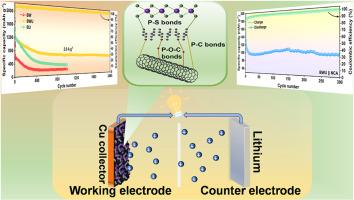高性能锂离子电池用P-C和P-S键双键黑磷复合材料
IF 7.9
2区 工程技术
Q1 CHEMISTRY, PHYSICAL
引用次数: 0
摘要
锂离子电池以其优越的能量密度、优良的循环寿命和无记忆效应等优点,作为一种有前景的储能器件而受到广泛关注。然而,它们在高速性能和结构稳定性方面仍面临挑战,需要进一步优化。本研究重点研究了由黑磷(BP)、二硫化钨(WS2)和超高纯度晶须碳纳米管(UWCNTs) (BP-WS2-UWCNTs)组成的复合阳极材料。研究了材料界面磷碳键(P-C)和磷硫键(P-S)对电化学性能的调控作用。表征表明在复合界面处建立了P-C和P-S键,增强了结构完整性,提高了电子/离子传输能力。电化学性能评估验证了这些界面键的综合效应:在2.0 A g−1下,BP-WS2-UWCNTs阳极在2000次循环中提供605.8 mAh g−1,在15.0 A g−1下,在3000次循环后仍保持252.2 mAh g−1,表现出卓越的速率性能和延长的循环耐久性。在锂离子电池的实际应用中,复合阳极保持了坚固的结构完整性和优异的电化学性能。这项工作强调了界面P-C和P-S化学键的联合作用有效地促进了锂离子的扩散并稳定了电极结构,为推进锂离子电池的高容量阳极设计提供了有价值的见解和可行的策略。本文章由计算机程序翻译,如有差异,请以英文原文为准。

Dual-bonded black phosphorus composites with P–C and P–S linkages for high-performance lithium-ion batteries
Lithium-ion batteries (LIBs) attract widespread attention as promising energy storage devices owing to their superior energy density, excellent cycle life, and absence of memory effect. However, they still encounter challenges in high-rate performance and structural stability, necessitating further optimization. This study focuses on a composite anode material constructed from black phosphorus (BP), tungsten disulfide (WS2), and ultra-high-purity whisker carbon nanotubes (UWCNTs) (BP-WS2-UWCNTs). The research investigates the regulatory effects of phosphorus–carbon (P–C) and phosphorus–sulfur (P–S) bonds at the material interface on electrochemical performance. Characterization indicates the establishment of P–C and P–S bonds at the composite interface, which enhance structural integrity and improve electron/ion transport capabilities. Electrochemical performance evaluations validate the combined effect of these interfacial bonds: at 2.0 A g−1, the BP-WS2-UWCNTs anode delivers 605.8 mAh g−1 for 2000 cycles, and retains 252.2 mAh g−1 after 3000 cycles even at 15.0 A g−1, exhibiting remarkable rate performance and prolonged cycling durability. In practical applications of LIBs, the composite anode maintains robust structural integrity and outstanding electrochemical performance. This work highlights that the combined effect of interfacial P–C and P–S chemical linkages effectively facilitates lithium-ion diffusion and stabilizes the electrode structure, offering valuable insights and viable strategies for advancing high-capacity anode design in LIBs.
求助全文
通过发布文献求助,成功后即可免费获取论文全文。
去求助
来源期刊

Journal of Power Sources
工程技术-电化学
CiteScore
16.40
自引率
6.50%
发文量
1249
审稿时长
36 days
期刊介绍:
The Journal of Power Sources is a publication catering to researchers and technologists interested in various aspects of the science, technology, and applications of electrochemical power sources. It covers original research and reviews on primary and secondary batteries, fuel cells, supercapacitors, and photo-electrochemical cells.
Topics considered include the research, development and applications of nanomaterials and novel componentry for these devices. Examples of applications of these electrochemical power sources include:
• Portable electronics
• Electric and Hybrid Electric Vehicles
• Uninterruptible Power Supply (UPS) systems
• Storage of renewable energy
• Satellites and deep space probes
• Boats and ships, drones and aircrafts
• Wearable energy storage systems
 求助内容:
求助内容: 应助结果提醒方式:
应助结果提醒方式:


